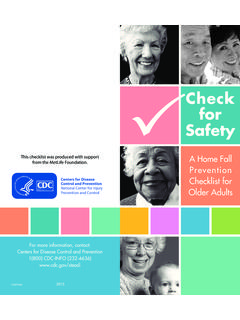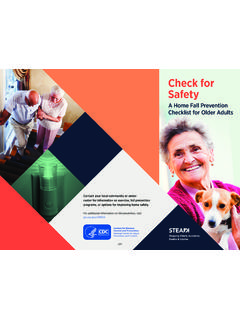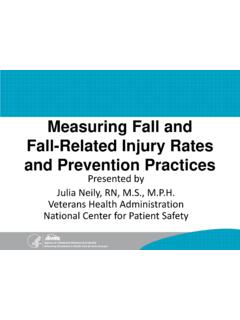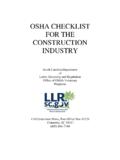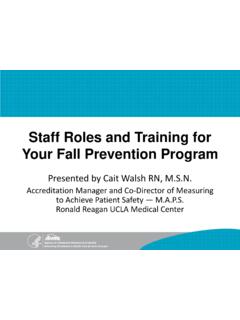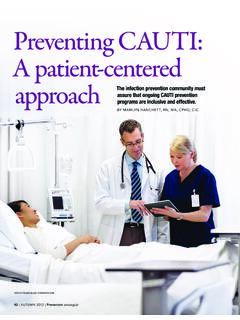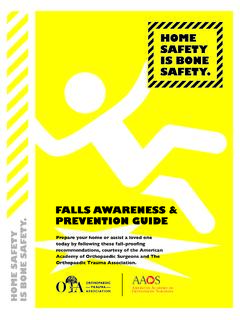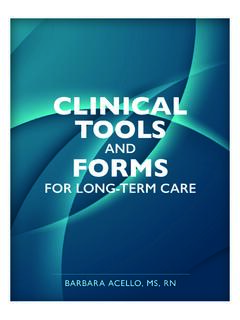Transcription of AFMAN 91-203 Checklists(V1.4) - Air Force Safety Center
1 AFMAN 91-203 . Air Force Occupational Safety , Fire and Health Standards checklist Introduction: The checklists contained herein is created by AFSEC/SEGS to assist Air Force personnel in meeting the requirements of AFMAN 91-203 . Where appropriate, MAJCOMs, FOAs, DRUs, local Safety offices and shop supervisors may download a copy of this checklist to add local or shop specific requirements. NOTE: Reference the checklist revision number to ensure you are using the most current. Table of Contents Table of Contents .. 1. CHAPTER 2: GENERAL WORK PROCEDURES 2-1. CHAPTER 3: WEATHER Safety checklist .. 3-1. CHAPTER 4: SERVICES OPERATIONS 4-1. CHAPTER 5: NDI AND OIL ANALYSIS checklist .. 5-1. CHAPTER 6: FIRE PROTECTION AND PREVENTION checklist .
2 6-1. CHAPTER 7: WALKING AND WORKING SURFACES checklist .. 7-1. CHAPTER 8: ELECTRICAL Safety checklist .. 8-1. CHAPTER 9: EMERGENCY SHOWER AND EYEWASH UNITS checklist .. 9-1. CHAPTER 10: GROUNDS, LAWN CARE, AND MOWING Safety checklist .. 10-1. CHAPTER 11: HAND TOOLS AND PORTABLE POWER TOOLS checklist .. 11-1. CHAPTER 12: MATERIALS HANDLING EQUIPMENT checklist .. 12-1. CHAPTER 13: FALL PROTECTION 13-1. CHAPTER 14: PERSONAL PROTECTIVE EQUIPMENT (PPE) checklist .. 14-1. CHAPTER 15: TRAINING SYSTEMS checklist .. 15-1. CHAPTER 16: MOBILE ELEVATING WORK PLATFORMS checklist .. 16-1. CHAPTER 17: SCAFFOLDING checklist .. 17-1. CHAPTER 18: HYDROCARBON FUELS checklist .. 18-1. CHAPTER 19: COMPRESSED GASES checklist .. 19-1. CHAPTER 20: Safety COLOR CODING, LABELING, AND MARKING FOR PIPING SYSTEMS.
3 20-1. CHAPTER 21: HAZARDOUS ENERGY CONTROL checklist .. 21-1. CHAPTER 22: FLAMMABLE AND COMBUSTIBLE 22-1. CHAPTER 23: CONFINED SPACES checklist .. 23-1. CHAPTER 24: AIRCRAFT FLIGHTLINE GROUND OPERATIONS AND ACTIVITIES checklist .. 24-1. CHAPTER 25: CIVIL ENGINEERING 25-1. CHAPTER 26: LIQUID NITROGEN (LN2), OXYGEN (LOX) AND CRYOGENS checklist .. 26-1. CHAPTER 27: WELDING, CUTTING, AND BRAZING checklist .. 27-1. Revision Date: 08 January 2020 Page | i AFMAN 91-203 . Air Force Occupational Safety , Fire and Health Standards checklist CHAPTER 28: INTERIOR SPRAY FINISHING checklist .. 28-1. CHAPTER 29: MISHAP PREVENTION SIGNS AND TAGS checklist .. 29-1. CHAPTER 30: COMMUNICATIONS CABLE, ANTENNA, AND COMMUNICATIONS SYSTEMS. 30-1.
4 CHAPTER 31: BATTERIES - MAINTENANCE, HANDLING, AND STORAGE REQUIREMENTS. 31-1. CHAPTER 32: MOTOR VEHICLES - OPERATION AND MAINTENANCE checklist .. 32-1. CHAPTER 33: COMPOSITE MATERIALS checklist .. 33-1. CHAPTER 34: PRECISION MEASUREMENT EQUIPMENT LABORATORY (PMEL) checklist .. 34-1. Revision Date: 08 January 2020 Page | ii AFMAN 91-203 . Air Force Occupational Safety , Fire and Health Standards checklist CHAPTER 2: GENERAL WORK PROCEDURES checklist . Does Not N/A to Question Compliant Comply this Org Q2-1. Do workers remove rings when they perform climbing, ascending or descending activities where personnel could fall or jump from elevated surfaces, , ladders, scaffolds, platforms, roofs or high reach vehicles, , refuelers, wreckers, sweepers, dump trucks and stake bed trucks?
5 Reference Q2-2. Do workers remove rings when performing materials handling operations, , warehousing, parts handling, operating equipment, packing and crating, and attaching/. detaching equipment to tow vehicles? Reference Q2-3. Do workers remove rings when performing any type of work where personnel are exposed to moving machinery, rotating or revolving parts or activities that could result in their hands being caught by a moving part and injured? Reference Q2-4. Do workers remove rings when performing work or inspection on or near energized electrical parts? Note: This prohibition includes conductive necklaces, bracelets, watches, etc. Reference Q2-5. Are metal eyeglasses secured by a band or cord to prevent them from falling into energized electrical circuits or moving industrial machinery?
6 Reference Q2-6. Are floors and walking surfaces where personnel walk and work free of potential tripping and slipping hazards such as tools, electrical cords, air lines and packaging materials? Reference Q2-7. Are telephone and electrical cords located where they do not pose a tripping hazard? Reference Q2-8. Are all stair and floor defects, such as loose tiles, broken steps, torn carpeting, loose or curled mats, and worn, frayed or damaged anti-slip material on stairs or inadequate lighting repaired or replaced? Reference Revision Date: 08 January 2020 Table of Contents Page | 2-1. AFMAN 91-203 . Air Force Occupational Safety , Fire and Health Standards checklist Does Not N/A to Question Compliant Comply this Org Q2-9. Are non-soiled excelsior (fine wood shavings), straw, shredded paper, recyclable cardboard, recyclable paper and other packing/recyclable materials stored in an isolated fire- resistant area and/or container?
7 Reference Q2-10. Are protruding nails, brads and staples from crates, cases, packing boxes, casks, boards and lumber removed to prevent injury to personnel? Reference Q2-11. When materials are stacked to a height less than 15 feet, has an 18-inch clearance below ceiling sprinkler deflectors been maintained? Reference Q2-12. Are stepstools or ladders used to access anything above shoulder level? Reference Q2-13. Is heavy material stored in bottom drawers and cabinets loaded from the bottom up? Reference Q2-14. Is access to fuse or circuit breaker boxes or electrical controls kept clear and unobstructed with panel doors closed to prevent electrical flashover if a malfunction occurs? Reference Q2-15. Are high amperage appliances such as refrigerators and coffee makers not plugged into modular office furniture unless the furniture electrical system is rated and certified by Civil Engineering for general appliance use?
8 Reference Q2-16. Do elevators stop level with the floor when the doors open to prevent a tripping hazard? Reference Q2-17. Do powered roll-up doors equipped with one touch open or close buttons have a crush sensor on the bottom of the door installed and operational? Reference Q2-18. Do powered doors in facilities not used as hangers meet the requirements in paragraph Reference Revision Date: 08 January 2020 Table of Contents Page | 2-2. AFMAN 91-203 . Air Force Occupational Safety , Fire and Health Standards checklist Does Not N/A to Question Compliant Comply this Org Q2-19. Are loading docks adhering to fall protection requirements in paragraph Reference Q2-20. Is a bypass or other type device installed on the door to permit escape from inside if an employee is locked inside?
9 Reference Revision Date: 08 January 2020 Table of Contents Page | 2-3. AFMAN 91-203 . Air Force Occupational Safety , Fire and Health Standards checklist CHAPTER 3: WEATHER Safety checklist . Does Not N/A to Question Compliant Comply this Org Q3-1. Does the supporting Air Force weather organization make initial notification to predetermined support agencies in the event of or forecast of adverse weather conditions? Reference Q3-2. Has the installation developed local procedures to ensure personnel and agencies involved in high weather risk activities are notified and adverse weather precautions are taken in a timely manner? Reference Q3-3. Is a two-tier notification system established to minimize personnel exposure to lightning?
10 Reference Q3-4. Is a lightning watch initiated 30 minutes prior to thunderstorms being within 5 nautical miles radius of any predetermined location or activity as forecast by the supporting AF weather organization? Reference Q3-5. Is a lightning warning in effect whenever any lightning occurs within a 5 nautical miles radius of any predetermined location or activity as forecast by the supporting AF weather organization? Reference Q3-6. Do all outside activities cease and personnel seek adequate shelter during a lightning warning? Reference Q3-7. When lightning is detected or observed, are actions taken to minimize personnel exposure to lightning hazards? Reference Q3-8. When lightning is detected or observed in the immediate vicinity, do personnel seek shelter in protected buildings or shelters?
